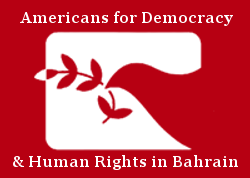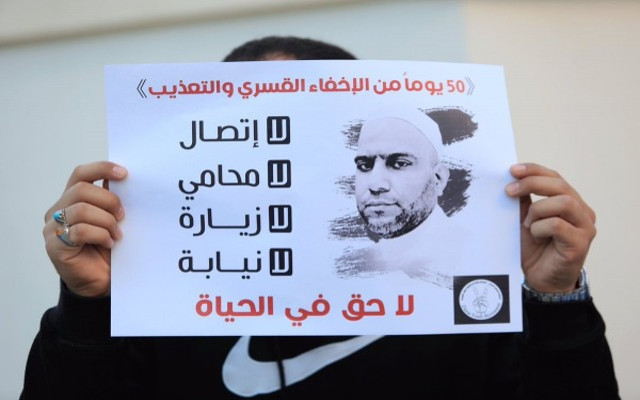A case recently documented by ADHRB provides a particularly dramatic example of the Bahraini state’s practice of enforced disappearance, a compound form of human rights abuse that has become recurrent in recent years. Sayed Alawi Husain disappeared from his work on 24 October 2016, and his family soon learned that he had been detained by agents of the state – but without being told where he was held, as one state agency after another denied knowledge of and responsibility for his whereabouts. Bahraini citizens like Sayed are frequently detained without cause or warrant and typically disappear into the Criminal Investigations Directorate for several days or even weeks of abuse before reemerging in prison and/or courtroom proceedings. Sayed Alawi’s case mirrors this regular pattern, but is more egregious in that he has been kept almost entirely incommunicado for what is now close to half a year. The emergence of long-term enforced disappearances in Bahrain would mark an extremely alarming escalation of repression.
Details of the Case
Sayed Alawi was last seen at his work as a repair inspector for the Bahrain Telecommunications Company on 24 October of last year. Information collected by ADHRB indicates that he was taken from a worksite by armed men in civilian clothing. In the tightly controlled social environment of Bahrain, such an action can only be the work of agents of the state.
When Sayed did not come home or answer his phone that evening, his family was forced to set out on a Kafkaesque ordeal to attempt to find out what had happened to him. They went to the nearest police station on the night of the disappearance to file a missing-person report. The police called around to other agencies and told the family that Sayed Alawi was nowhere to be found. Less than an hour after leaving the station, however, the family received a call from the police telling them they had to come back and retract their report because Sayed was being held in the custody of the Criminal Investigations Directorate (CID). They did as they were told, but weren’t allowed to speak to him on the phone or given any information on how and when they could see him. The only concrete piece of information offered by the police was that Sayed had been taken by the CID to Adliya, a neighborhood of the Bahraini capital Manama.
The next day Sayed’s family filed a complaint with the Ministry of Interior’s Office of the Ombudsman, one of Bahrain’s mostly ineffective human rights and reform institutions. The Ministry of Interior is in charge of the CID, so the inquiry was addressed to the right place if, as the police had said, Sayed was being held by that agency. The Ombudsman’s office received the complaint but, despite continuous follow-up from the family, has never disclosed any substantive information about where Sayed is or what has happened to him.
The next day, now two days after the disappearance, the family took it upon themselves to go on their own to the CID office in Adliya. (Given that the CID is known for its use of torture, this no doubt took considerable courage.) The personnel there flatly denied that Sayed Alawi was in their custody as the police had said.
After nearly a week with no news from the police, the Ombudsman, or any other responsible government office, the family returned to the CID office to press again for information. This time the officials there refused to either confirm or deny that Sayed Alawi was in their custody.
Two days later, the CID called the family and informed them that Sayed had been transferred to Dry Dock, a well-known detention facility in Bahrain. The family was told they should go there on 6 November and would be allowed to see Sayed – for the first time in nearly two weeks since he had been disappeared.
They went, as they were told, on 6 November. The prison authorities denied that any Sayed Alawi was being held there.
The next day the family received a tip from an attorney that Sayed had been brought for an appointment at the Office of the Public Prosecutor and was, in fact, being held at Dry Dock. So the next day, again, they went to Dry Dock; and, again, were told that Sayed wasn’t there. The family went immediately to the Office of the Public Prosecutor, where they were stonewalled yet again. One employee, however, was willing to tell them that Sayed was under the authority of the prosecutor’s division for terrorist crimes. They delivered a letter to that department requesting a visit with their disappeared loved one, to no effect.
Finally, at the end of November, over a month after he had disappeared, Sayed Alawi called his family, in captivity, from a blocked number. He was not allowed to talk to them for even five minutes, and when asked where he was he could say only “with Investigations [i.e., the CID].” They received another call from him about half a month later, and then a third call a month-and-a-half after that. None of the calls lasted ten minutes, and Sayed Alawi was never able to say where he was or when they might visit him. In fact, it seemed to the family, he was being forced to end the call as soon as the conversation started to turn towards where he was and what was happening to him.
Sayed’s family have not spoken with him since the end of February. In the five-and-a-half months since he was taken, they have not had a half-hour’s conversation on the phone with him. It is known that he is in the hands of the state, but not where, in what condition, or with what justification. While it is no doubt some very small comfort to know that he is alive (at least as of the last phone call), they do not know how he is being treated and are left to imagine the worst. Given the CID’s record, the picture is not reassuring. There is nothing in their power to do to help or even to see him. This is enforced disappearance.
The Fundamental Illegality of Enforced Disappearance
Disappearance has been described by Judge Antônio Augusto Cançado Trindade, former head of the Inter-American Court of Human Rights and now a member of the International Court of Justice, as “one of the most cruel and perverse violations of human rights.”[1] Though it has likely been practiced by oppressive regimes far into the distant past, it became notorious in the twentieth century as a policy of Nazi Germany. Under what is known as the “Night and Fog” decree,[2] the fate of captured dissidents was intentionally hidden in order to sow terror throughout society. “An effective and lasting deterrent” to civilian opposition, in the words of the decree, “can be achieved only … by taking measures which will leave the family and the population uncertain as to the fate of the offender.”[3] The Nazi bureaucracy noted that “The decree introduces a fundamental innovation”[4]: “(a) the prisoners will vanish without leaving a trace, [and] (b) no information may be given as to their whereabouts or their fate.” Only acting “secretly” in this manner, without publicly known “criminal proceedings,” was expected to have “the necessary deterrent effect.”[5] Thus “uncertainty about the fate of prisoners among their relatives and acquaintances”[6] was to be cultivated for its terrorizing effect. Disappearance was again dragged to the forefront of notoriety when it swept like a scourge through Latin America in the 1970s, from Guatemala to Chile.
Disappearance manages to simultaneously and perforce violate a large number of discrete human rights. At minimum it negates the rights to “liberty and security of person,”[7] to “be treated with humanity and with respect for the inherent dignity of the human person,”[8] “to recognition everywhere as a person before the law,”[9] to “be brought promptly before a judge” for “trial within a reasonable time,”[10] to habeas corpus,[11] “to communicate with counsel of [one’s] own choosing”[12] and defend oneself legally with that counsel’s assistance,[13] “to be presumed innocent until proved guilty according to law,”[14] to receive “a fair and public hearing by a competent, independent and impartial tribunal established by law,”[15] and “to obtain the attendance and examination of witnesses on [one’s] behalf.”[16] It egregiously violates the prohibitions on “arbitrary arrest or detention”[17] and on “cruel” and “inhuman” treatment,[18] and at least colorably meets the threshold of “severe [mental] pain or suffering” in the international legal definition of torture.[19] It disregards the instructions that the prison system is to seek “reformation and social rehabilitation”[20] and that the family unit “is entitled to protection by … the State.”[21] It also, almost needless to say, violates the state’s duty “to respect and to ensure” the rights of “all individuals … subject to its jurisdiction,”[22] and the associated prohibition on discrimination,[23] since disappearance is practiced on the discriminatory basis of (perceived) political opinion, at a minimum (while often overlapping with ethnic and social bigotry). It is a kind of standing violation of the duty to make redress for wrongs,[24] since its essence is arbitrary detention untethered from any possible mechanism of accountability. The crime of enforced disappearance is also notable for creating a set of secondary victims, made up of the disappeared person’s loved ones, who also endure cruel and inhuman treatment (and, again arguably, mental torture) as they are deprived of any certain knowledge of their disappeared intimate’s fate.
The essential legal nature of enforced disappearance is the removal of the person taken from the protective sphere of law. This is its purpose, legally, just as its social purpose is to spread terror. It has accordingly been treated as a noxious practice by international jurists. “In our days, no one would dare to deny the objective illegality of acts of … enforced disappearance,” Judge Trindade writes.[25] Based as they are on the history of Latin America, which arguably has the most extensive and notorious experience with enforced disappearance, these words should carry considerable weight. Yet to judge by Bahrain’s actions, Trindade may – regrettably – have spoken too soon. If the case of Sayed Alawi is indicative, it seems that Bahrain acts as though disappearance is, in fact, just a part of the law of the land.
[1] Antônio Augusto Cançado Trindade, “Enforced Disappearances of Persons as a Violation of Jus Cogens: The Contribution of the Jurisprudence of the Inter-American Court of Human Rights,” Nordic Journal of International Law, vol. 81 (2012), no. 4, pp. 507-36, at p. 508.
[2] See International Military Tribunal (IMT), Trial of the Major War Criminals Before the International Military Tribunal (14 November 1945 – 1 October 1946), vol. IV, Proceedings: 17 December 1945 – 8 January 1946 (Nürnberg: IMT, 1947), p. 271, remarks of 2 January 1946 by U.S. prosecutor Col. Robert Storey.
[3] Order of 12 December 1941 signed by head of the Armed Forces High Command Wilhelm Keitel, excerpt translated in ibid., p. 272.
[4] Letter of 2 February 1942 on stationery of S.S. chief Heinrich Himmler’s office, excerpt translated in ibid.
[5] Ibid., p. 273.
[6] Letter of 24 June 1942 from Chief of Security Police and the Security Service Reinhard Heydrich, excerpt translated in ibid., p. 274.
[7] International Covenant on Civil and Political Rights, text adopted 16 December 1966, United Nations Treaty Series, vol. 999 (1976) (New York: United Nations, 1983), treaty no. 14668, pp. 171-86 (henceforth cited as “ICCPR”), Art. 9.1, at p. 175. Bahrain signed on to the Covenant in 2006. Idem, vol. 2386 (2006) (New York: United Nations, 2010), p. 288.
[8] ICCPR, Art. 10.1, p. 176.
[9] Ibid., Art. 16, p. 177.
[10] Ibid., Art. 9.3, p. 175, and accord Art. 14.3(c), p. 177 (right “[t]o be tried without undue delay”).
[11] Or, in the language of international law: “Anyone who is deprived of his liberty by arrest or detention shall be entitled to take proceedings before a court, in order that that court may decide without delay on the lawfulness of his detention and order his release if the detention is not lawful.” Ibid., Art. 9.4, p. 176.
[12] Ibid., Art. 14.3(b), p. 177.
[13] Ibid., Art. 14.3(d).
[14] Ibid., Art. 14.2, p. 176.
[15] Ibid., Art. 14.1.
[16] Ibid., Art. 14.3(e), p. 177.
[17] Ibid., Art. 9.1, p. 175.
[18] Ibid., Art. 7, p. 175.
[19] Convention Against Torture and Other Cruel, Inhuman, or Degrading Treatment or Punishment, text adopted 10 December 1984, pp. 113-22 in United Nations Treaty Series, vol. 1465 (1987) (New York: United Nations, 1996), Art. 1.1, at p. 113.
[20] ICCPR, Art. 10.3, p. 176.
[21] Ibid., Art. 23.1, p. 179.
[22] Ibid., Art. 2.1, p. 173.
[23] Ibid., Arts. 2.1 and 26, pp. 173, 179.
[24] Ibid., Arts. 2.3 and 9.5, pp. 174, 176.
[25] Trindade, op. cit., p. 536.





